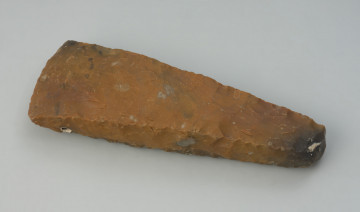
Flint adze
National Museum in Szczecin
Part of the collection: Stone Age
The axe is one of the six items from the flint tool collection that found its way to the Szczecin museum collection in 1969 thanks to the help of a postman from Nowe Warpno. They were discovered by accident during land improvement works carried out in Warnołęka. The deposit contains tools made from lumps of chalk-age flint, greyish-white in colour, the surfaces of which bear traces of negatives from shape-forming reflections. They are prepared for grinding, smoothing and polishing of the surface. They all have a four-sided form and narrow shanks. However, they are characterised by differences in the shape of the blade, which in front view is straight or curved. Probably these half tools of similar shape were intended for different works - one was used as an axe for chopping and ploughing, the other as a chisel for gouging and hollowing. The rusty colour of the surface of tools from Warnołęka is the effect of patination during their deposition in a humid environment for several thousand years. Such patina is sometimes associated with flint occurring in large concretions in chalky formations on Rügen. The deposits there were exploited on a large scale by the people of the Funnel Beaker culture, and multi-walled tools made from Rügen material were distributed over long distances, also beyond the Oder, although in West Pomerania, e.g. in the Kamień-Wolin region, flint with similar characteristics from deposits of Cretaceous age can be found. Several finds of clustered flint axes are known from West Pomerania. It seems that their presence, especially assemblages with products without traces of honing, is related to the distribution of prepared tool forms from areas where there is a raw material suitable for large flint products. In some cases, the deposits had intentional arrangements, such as axes hammered into the ground forming a circle, suggesting connection to Ritualism.
Krzysztof Kowalski
Author / creator
Dimensions
cały obiekt: height: 16.6 cm, width: 5.9 cm
Object type
axe
Technique
carving
Material
flint, stone
Origin / acquisition method
acquisition
Creation / finding place
Owner
National Museum in Szczecin
Identification number
Location / status